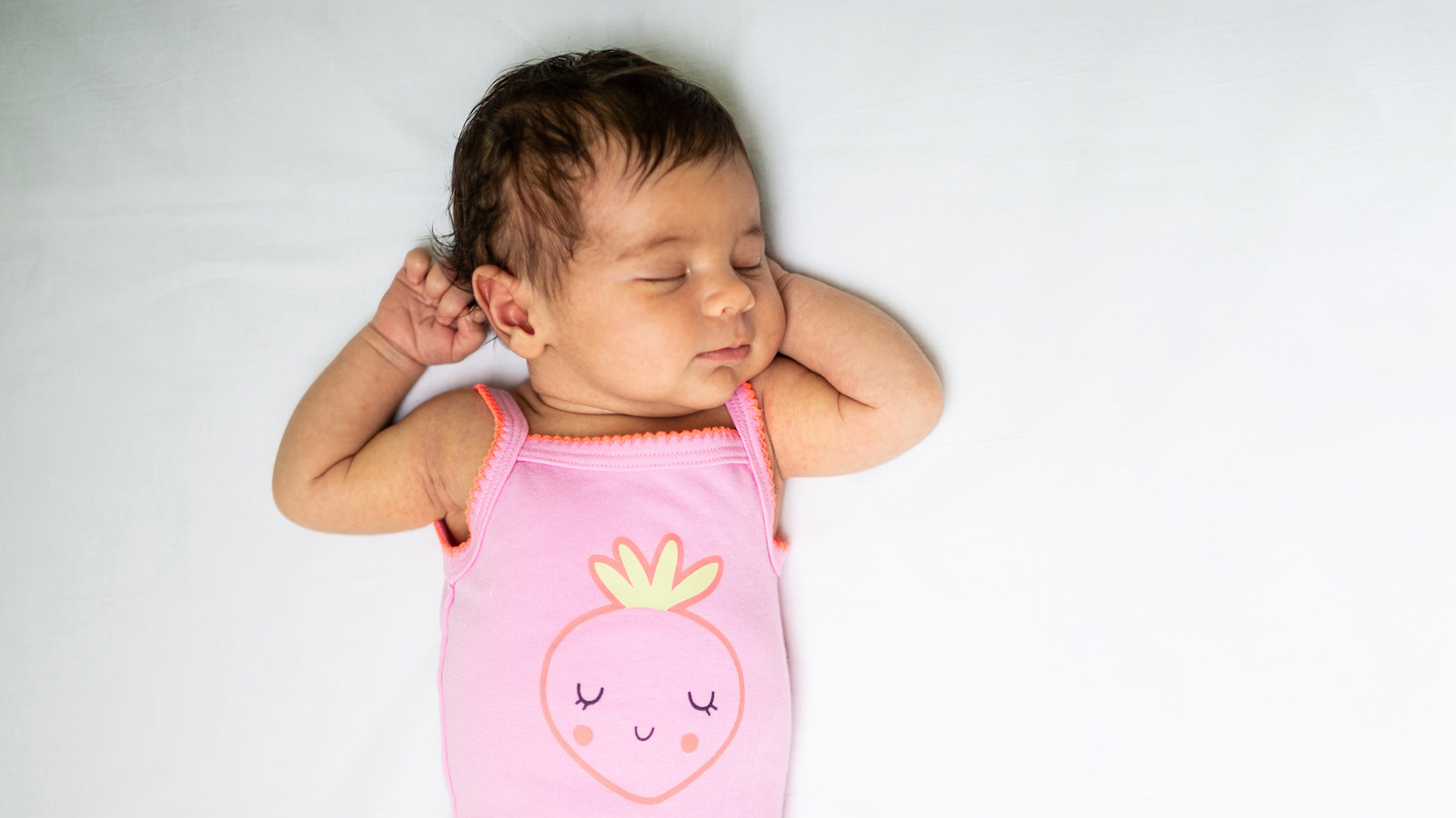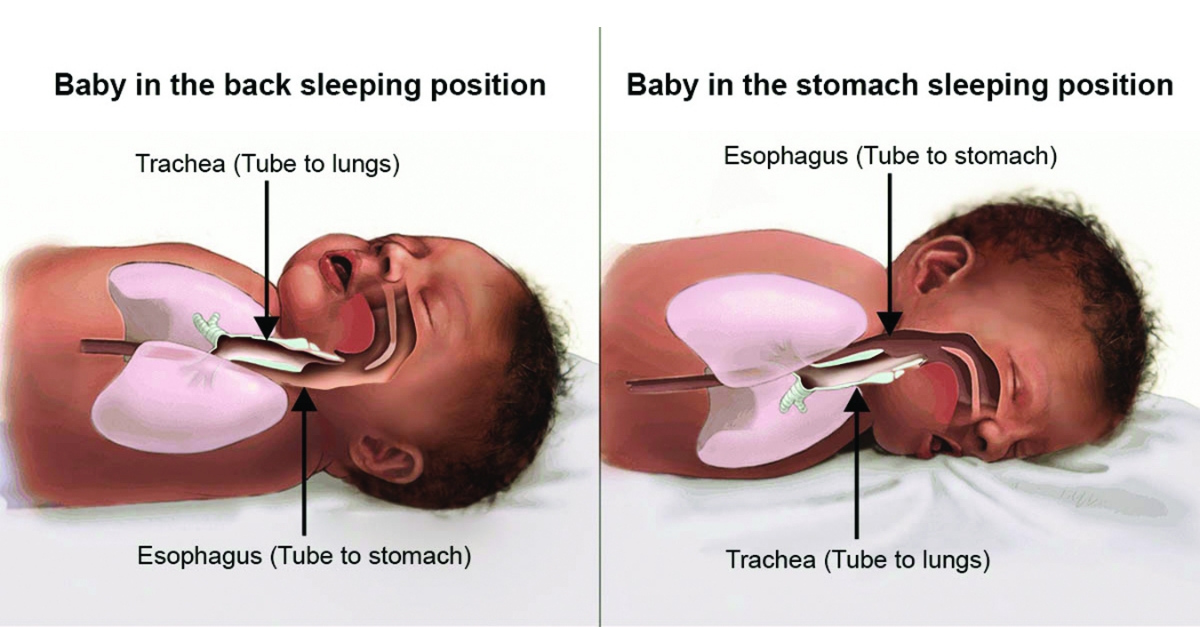
The most effective action that parents and caregivers can take to reduce baby’s risk of Sudden Infant Death Syndrome (SIDS) and other sleep-related death is to always place baby on their back to sleep, for naps and at night.
The back sleep position is the safest sleep position for all babies, including those born preterm and those with reflux, until they are 1 year old.
Sleeping on the stomach increases the risk of:
- Overheating
- Rebreathing expired air (air that has already been breathed out), which can lead to:
- Too much carbon dioxide in baby’s body (called hypercapnia)
- Too little oxygen in the baby’s body (called hypoxia)
- Temporary changes in heart and lung function and control, which could affect the amount of oxygen getting to the brain
Back sleeping is not associated with these risks.
No. Side sleeping is not recommended, because the side sleep position is unstable. Babies who are placed to sleep on their sides are more likely to fall onto their stomach, the position associated with highest risk for SIDS.1
Some research suggests that the SIDS risk for babies who sleep on their sides and then fall onto their stomachs is much higher than the risk for babies who are always placed to sleep on their stomachs.
Babies should be placed wholly on their backs for naps and at night to reduce the risk of SIDS.
Once babies can roll from back to stomach and from stomach to back on their own, you can leave them in the position they choose after starting sleep on their back. If they can roll only one way on their own, you can reposition them to their back if they roll onto their stomach during sleep.
Rolling over is an important and natural part of your baby’s growth. Babies may start rolling over on their own as early as 2 months of age.
Stop swaddling baby during sleep once they start rolling over on their own, to reduce the risk of suffocation, entrapment, and strangulation.
No. Babies will not choke if they spit up or vomit while sleeping on their backs. Healthy babies naturally swallow or cough up fluids. It’s a reflex all people have to keep the airway clear. In fact, babies who sleep on their backs might be less likely to choke than babies who sleep on their stomachs, because of how the body is built.
- When baby is sleeping on their back, the opening of the tube to the lungs (also called the trachea or windpipe) sits on top of the opening of the tube to the stomach (called the esophagus). Fluids that come from the stomach have to work against gravity to get into the windpipe and cause choking.

- When baby is sleeping on their stomach, the opening of the tube to the stomach is on top of the opening of the tube to the lungs. Because of gravity, fluids that come from the stomach will collect at the opening of the tube to the lungs, making choking much more likely.
Infant deaths from choking during sleep are very rare. Studies also show no increase in the number of U.S. infant deaths from choking since the recommendations for back sleeping began in the 1990s.
No. Putting a baby who usually sleeps on their back onto their stomach or side to sleep, even just for a nap, greatly increases the risk for SIDS, up to 45 times higher in some studies. Everyone who cares for your baby should always place them on their back to sleep, for all sleep times, including naps, to reduce the risk of SIDS.
Safe Infant Sleep for Trusted Caregivers (7.5 min)
This video educates grandparents and other trusted caregivers about ways to reduce the risk of SIDS and other sleep-related infant deaths.
Yes. Current evidence shows that even babies with gastroesophageal reflux (in which acidic stomach juices or food and fluids back up from the stomach into the throat) should be placed on their backs to sleep.
Research also shows that raising one end of the crib or crib mattress is not effective at reducing reflux or reflux symptoms. This practice is also dangerous for babies because they may slide down in the sleep space, which could affect their ability to breathe properly. Keeping baby on a firm, flat, and level sleep surface is recommended.
Check out this article from the American Academy of Pediatrics (AAP) for more information:
What is the safest sleep solution for my baby with reflux?
Talk with your healthcare provider if you have a concern about your baby’s sleep position because of reflux or another medical condition.
The earlier you start placing baby on their back to sleep, the more quickly they will adjust to the position. But parents and caregivers should place babies on their backs to sleep even if they seem less comfortable or sleep more lightly than when on their stomachs.
A baby who wakes up often during the night should not be viewed as a “poor sleeper.” Waking up during the night is developmentally normal, and being able to wake up is an important milestone. Problems with the ability to wake may contribute to SIDS.
Although some babies may take longer than others to feel comfortable, most babies get used to sleeping on their backs quickly.
There are things parents and caregivers can do to help calm a fussy baby that can help with sleep.
Check out this information from American Academy of Pediatrics (AAP): How to Calm a Fussy Baby. You can also discuss your questions or concerns about baby’s sleep patterns with your healthcare provider.
No. Knowledge about SIDS, reducing the risk, and general infant health has changed a lot over the years. Caregivers were doing their best with the knowledge available at the time. Today, we know that sleeping on the stomach increases the risk for SIDS and that the back sleeping position is best to reduce the risk of SIDS.
Many infant care practices have changed over the years. For example, seat belts and car seats are more common today than even just a decade ago. Discussing baby’s sleep position is like discussing the use of seat belts and car seats—not better or worse, just different from what people did before.
It can be challenging to talk about new information and care practices with grandparents and other caregivers. They may feel you are questioning their parenting skills or that you are blaming them for doing something “wrong.” But the opposite is true—their careful caregiving contributed to the evidence for today’s safe sleep recommendations. Everyone wants baby to grow up healthy, and back sleeping is one way to help make that happen.
Some babies may develop flat spots on the back of their heads from spending long periods of time lying on their backs or from having the back of the head pressed against a surface, such as a car seat or carrier, too often or for a long period of time. Such flat spots are usually not dangerous and typically go away on their own once baby starts sitting up. The flat spots are not linked to long-term problems with head shape.
Parents and caregivers can help prevent these flat spots in a number of ways. Learn more about tummy time and preventing flat spots on baby's head.
- Moon, R. Y., Carlin, R. F., Hand, I. Task Force on Sudden Infant Death Syndrome, & Committee on Fetus and Newborn. (2022). Sleep-related infant deaths: Updated 2022 recommendations for reducing infant deaths in the sleep environment. Pediatrics, 150(1), e2022057990. Retrieved December 23, 2022, from https://pubmed.ncbi.nlm.nih.gov/35726558/.

